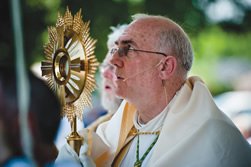
Mark your calendar for the annual Corpus Christi procession June 10 at the Cathedral of the Immaculate Conception, 416 W. 12th St., Kansas City, Mo.
The schedule for the day is:
11 a.m. – Solemn Pontifical Mass
12:15 p.m. – Solemn Exposition of the Blessed Sacrament
1:15 p.m. – Homily delivered by Archbishop Joseph F. Naumann.
1:30 p.m. – Procession from the Cathedral to the Catholic Center, 20 W. 9th St. (approximately mile). Benediction will be celebrated at the Chapel of Our Lady of Ephesus at the Catholic Center. A reception will follow.
by Woodeene Koenig-Bricker
“Catholicism, like the Gospels, is not about abstractions and symbols. It is about the real power of the Savior and his real presence in the world,” said Father Augustine Thompson, OP, professor of history at the Dominican School of Philosophy and Theology and a member of the core doctoral faculty of the Graduate Theological Union in Berkeley, Calif.
That’s why the feast of Corpus Christi (Latin for “the Body of Christ”), celebrated on June 10 this year in the United States, is central to the faith.
The feast, which honors the real presence of Christ in the Eucharist, is one of the few celebrations that doesn’t commemorate an event in the life of Jesus or Mary.
Instead, it is dedicated to a fundamental tenet of Catholicism — that Jesus is physically with us in the consecrated bread and wine.
While the reality of Christ in the Eucharist has been part of the faith since the Last Supper, this unique official celebration of the Real Presence didn’t begin until the 13th century.
It was then that a medieval mystic, Juliana of Liège, who had a lifelong devotion to the Eucharist, began petitioning her bishop to institute such a commemorative.
Eventually, the practice spread and, in 1264, Pope Urban IV issued a papal bull, “Transiturus de hoc mundo,” making Corpus Christi the first papally sanctioned universal feast in the history of the Church.
In his proclamation, Pope Urban wrote:
“ . . . in this sacramental commemoration of Christ, Jesus Christ is truly present, albeit under another form, He is truly with us in His very own substance. Indeed, as He was about to ascend into Heaven, He said to the Apostles and to their followers: ‘Behold, I am with you all days, even to the consummation of the world’ (Mt 28:20), comforting them by the gracious promise, that He would abide and be with them even in his bodily presence.”
What makes this feast even more unusual is that the “feast was first conceived by laypeople, it was promoted by laypeople, and finally the clerics got around to recognizing lay wisdom,” said Father Augustine.
In fact, the “founder,” Juliana of Liège, “was a freelance holy woman — not a nun as the usual versions say,” he added. In addition, Father Augustine points out that the major promoters of the feast were virtually all women.
The feast is particularly important today, he added, because it shows that the “church needs to listen to the spiritual wisdom of the laity. Today, devotion to the Real Presence by [eucharistic] adoration is again a lay movement. The clergy need to listen more to the Spirit speaking through the laity on matters of piety and devotion.”
Indeed, eucharistic adoration, sometimes called perpetual adoration, is a growing movement throughout the country. Growing out of the practice of venerating the Blessed Sacrament, which occurs in eucharistic processions on the feast of Corpus Christi, the consecrated host is put in a place of honor where the faithful come to spend time in prayer and adoration around the clock.
In his 1965 encyclical, “Mysterium Fidei” (“Mystery of Faith”), Pope Paul VI taught that “The Catholic Church has always offered and still offers the worship of latria (adoration) to the sacrament of the Eucharist, not only during Mass, but also outside it. It does so by reserving consecrated hosts with the utmost care, exposing them to solemn veneration by the faithful and carrying them in processions to the joy of great crowds of the faithful” (No. 56).
“Eucharistic adoration is one of the most important ways in which the presence of Christ continues in the church following the celebration of Mass,” explained Father James Patrick Moroney, then-executive director of the USCCB Secretariat for the Liturgy, at a 1998 symposium on adoration of the Blessed Sacrament in St. Louis. “And as such, it is meant both to help us sanctify everything we do and to draw us back to our next celebration of the Eucharist.”
Adoration chapels have been close to the hearts of both Blessed John Paul II, who prayed for a chapel in every parish in the world, and Pope Benedict XVI, who instituted perpetual adoration in each of the six suburbicarian dioceses of Rome.
Currently, there are more than 2500 perpetual adoration chapels around the world. The United States has approximately 1,1000, including at least four in Kansas. St. Joseph Parish in Shawnee is celebrating its 25th year of perpetual adoration on June 9.
While perpetual adoration is a growing devotion in many parishes, the seminal feast of Corpus Christi is an annual reminder that Christ is with his people — not just in memory, but in reality, until the end of time.
Although the feast is not always seen as one of the highlights of the liturgical year, said perhaps it should be, said Father Augustine.






